Characterizing Gas Hydrate–Bearing Marine Sediments Using Elastic Properties—Part 1: Rock Physical Modeling and Inversion from Well Logs
Abstract
:1. Introduction
2. Methods
2.1. Rock Physic Models for Marine Sediments Containing Gas Hydrates
2.2. Model-Based Methodology for the Estimation of the Gas Hydrate Concentration from Well-Log Data
3. Results
3.1. Modeling Analyses of Wave Velocities of Marine Sediments Associated with Gas Hydrates
3.2. Log Data of Marine Sediments in the Shenhu Area in the Northern Part of the South China Sea
3.3. Modeling P-Wave Velocity of Marine Sediments Containing Gas Hydrates
3.4. Estimation of the Gas Hydrate Concentration from the P-Wave Velocity Log
3.5. Influence of the Sc Value on Sgh Estimation
3.6. Correlation Analyses of VP versus Sgh, φ, and Cgh
4. Discussion
5. Conclusions
- A critical value of the gas hydrate saturation was introduced to the proposed RPM as a key parameter for different modeling schemes. In this way, the proposed RPM is capable of considering the impact of gas hydrates on the sediment stiffnesses during the dynamic accumulation process of the gas hydrates, including being pore fillings and forming part of the solid components.
- The proposed model takes into account the pore-filled gas hydrate fabric to exhibit non-zero bulk and shear moduli. Therefore, gas hydrates and water mixture was regarded as solid pore fillings saturated in the dry sediment frame.
- Theoretical modeling illustrates the elastic properties of the marine sediments exhibit various variation trends determined by Sc. The increase in Sgh considerably elevates the values of VP and vs. of sediments, with the velocities increasing more rapidly for Sgh values beyond the Sc value. This issue is mainly attributed to the fact that gas hydrates become part of the solid component of sediments and noticeably affect sediment stiffness for Sgh higher than Sc.
- The numerical experiment of the RPM using well-log data validates that the proposed model can be employed to estimate the gas hydrate saturation based on the elastic properties of marine sediments. The elevated VP values within target depth intervals can be utilized to infer the gas hydrate saturation.
- The quantitative gas hydrate saturation estimation leads to results agreeing with the core measurement data, confirming the applicability of the proposed method for reliable estimation of the gas hydrate saturation based on the elastic properties.
Author Contributions
Funding
Institutional Review Board Statement
Informed Consent Statement
Data Availability Statement
Conflicts of Interest
References
- Kvenvolden, K.A. Gas hydrates-geological perspective and global change. Rev. Geophys. 1993, 31, 173–187. [Google Scholar] [CrossRef]
- Minshull, T.A.; Singh, S.C. Seismic velocity structure at a gas hydrate reflector, offshore western Columbia, from full waveform inversion. J. Geophys. Res. Solid Earth 1994, 99, 4715–4734. [Google Scholar] [CrossRef]
- Ecker, C.; Lumley, D.; Dvorkin, J.; Nur, A. Structure of hydrate sediment from seismic and rock physics. In Proceedings of the International Conference on Natural Gas Hydrates, Toulouse, France, 2–6 June 1996. [Google Scholar]
- Boswell, R. Is gas hydrate energy within reach? Science 2009, 325, 957–958. [Google Scholar] [CrossRef] [PubMed]
- Timur, A. Velocity of compressional waves in porous media at permafrost temperature. Geophysics 1968, 33, 584–595. [Google Scholar] [CrossRef]
- Pearson, C.F.; Halleck, P.M.; McGuire, P.L.; Hermes, R.; Mathews, M. Natural gas hydrate deposit: A review of in situ properties. J. Phys. Chem. 1983, 87, 4180–4185. [Google Scholar] [CrossRef]
- Yuan, T.; Hyndman, R.D.; Spence, G.D.; Desmons, B. Seismic velocity increase and deep-sea gas hydrate concentrations above a bottom-simulating reflector on the northern Cascadia continental slope. J. Geophys. Res. 1996, 101, 13655–13671. [Google Scholar] [CrossRef]
- Wyllie, M.R.J.; Gregory, A.R.; Gardner, G.H.F. An experimental investigation of factors affecting elastic wave velocities in porous media. Geophysics 1958, 23, 459–493. [Google Scholar] [CrossRef]
- Lee, M.W.; Hutchinson, D.R.; Collett, T.S.; Dillon, W.P. Seismic velocities for hydrate bearing sediments using weighted equation. J. Geophys. Res. 1996, 101, 20347–20358. [Google Scholar] [CrossRef]
- Wood, A.B. A Textbook of Sound; G. Bell and Sons, Ltd.: London, OH, USA, 1941. [Google Scholar]
- Nobes, D.C.; Viilinger, H.; Davis, E.E.; Law, L.K. Estimation of marine sediment bulk physical properties at depth from seafloor geophysical measurements. J. Geophys. Res. 1986, 91, 14033–14043. [Google Scholar] [CrossRef]
- Dvorkin, J.; Prasad, M.; Sakai, A.; Lavoie, D. Elasticity of Marine Sediments: Rock Physics Modeling. Geophys. Res. Lett. 1999, 26, 1781–1784. [Google Scholar] [CrossRef]
- Mindlin, R.D. Compliance of elastic bodies in contact. J. Appl. Mech. 1949, 16, 259–268. [Google Scholar] [CrossRef]
- Hashin, Z.; Shtrikman, S. A variational approach to the theory of the elastic behavior of multiphase materials. J. Mech. Phys. Solids 1963, 11, 127–140. [Google Scholar] [CrossRef]
- Helgerud, M.B.; Dvorkin, J.; Nur, A.; Sakai, A.; Collett, T.S. Elastic-wave velocity in marine sediments with gas hydrates: Effective medium modeling. Geophys. Res. Lett. 1999, 26, 2021–2024. [Google Scholar] [CrossRef]
- Dai, J.; Banik, N.; Gillespie, D.; Dutta, N. Exploration for gas hydrates in the deepwater, northern Gulf of Mexico: Part II. Model validation by drilling. Mar. Pet. Geol. 2008, 25, 845–859. [Google Scholar] [CrossRef]
- Dai, J.; Snyder, F.; Gillespie, D.; Koesoemadinata, A.; Dutta, N. Exploration for gas hydrates in the deepwater northern Gulf of Mexico: Part I. A seismic approach based on geologic model, inversion and rock physics principles. Mar. Pet. Geol. 2008, 25, 830–844. [Google Scholar] [CrossRef]
- Shankar, U.; Riedel, M. Heat flow and gas hydrate saturation estimates from Andaman Sea, India. Mar. Pet. Geol. 2013, 43, 434–449. [Google Scholar] [CrossRef]
- Ehsan, M.I.; Ahmed, N.; Khalid, P.; Wei, L.X.; Naeem, M. An application of rock physics modeling to quantify the seismic response of gas hydrate-bearing sediments in Makran accretionary prism, offshore, Pakistan. Geosci. J. 2016, 20, 321–330. [Google Scholar] [CrossRef]
- Chand, S.; Minshull, T.M. The effect of hydrate content on seismic attenuation: A case study for Mallik 2L-38 well data, Mackenzie delta, Canada. Geophys. Res. Lett. 2004, 31, L14609. [Google Scholar] [CrossRef]
- Chand, S.; Minshull, T.M.; Priest, J.A.; Best, A.T.; Clayton, C.R.I.; Waite, W.F. An effective medium inversion algorithm for gas hydrate quantification and its application to laboratory and borehole measurements of gas hydrate-bearing sediments. Geophys. J. Int. 2006, 166, 543–552. [Google Scholar] [CrossRef]
- Guo, Z.Q.; Wang, X.Y.; Jiao, J.; Chen, H.F. Rock physics model and seismic dispersion and attenuation in gas hydrate-bearing sediments. Front. Earth Sci. 2021, 9, 641606. [Google Scholar] [CrossRef]
- Krief, M.; Garat, J.; Stellingwerff, J.; Ventre, J. A petrophysical interpretation using the velocities of P and S waves (full waveform sonic). Log Anal. 1990, 31, 355–369. [Google Scholar]
- Gassmann, F. Über die elastizitat poroser medien. Vierteljahr. Nat. Gesselschafi Zur. 1951, 96, 1–23. [Google Scholar]
- Ciz, R.; Shapiro, S.A. Generalization of Gassmann equations for porous media saturated with a solid material. Geophysics 2007, 72, 75–79. [Google Scholar] [CrossRef]
- Su, D.; White, N.; McKenzie, D.A.N. Extension and subsidence of the Pearl River mouth basin, northern South China Sea. Basin Res. 1989, 2, 205–222. [Google Scholar] [CrossRef]
- Yang, R.; Su, M.; Qiao, S.; Cong, X.; Su, Z.; Liang, J.; Wu, N. Migration of methane associated with gas hydrates of the Shenhu Area, northern slope of South China Sea. Mar. Geophys. Res. 2015, 36, 253–261. [Google Scholar] [CrossRef]
- Zhang, W.; Liang, J.; Su, P.; Wei, J.; Sha, Z.; Lin, L.; Liang, J.; Huang, W. Migrating pathways of hydrocarbons and their controlling effects associated with high saturation gas hydrate in Shenhu area, northern South China Sea. Chin. Geol. 2018, 45, 1–14. [Google Scholar]
- Wu, S.G.; Zhang, G.X.; Huang, Y.Y.; Liang, J.; Wong, H.K. Gas hydrate occurrence on the continental slope of the northern South China Sea. Mar. Pet. Geol. 2005, 22, 403–412. [Google Scholar] [CrossRef]
- Yu, X.; Wang, J.; Liang, J.; Li, S.; Zeng, X.; Li, W. Depositional characteristics and accumulation model of gas hydrates in northern South China Sea. Mar. Pet. Geol. 2014, 56, 74–86. [Google Scholar] [CrossRef]
- Deng, W.; Liang, J.Q.; He, Y.L.; Kuang, Z.G.; Meng, M.M. Rock-physics-based estimation of quartz content in the Shenhu area, South China Sea. Acta Geophys. 2020, 68, 1619–1641. [Google Scholar] [CrossRef]
- Su, M.; Sha, Z.B.; Qiao, S.H. Sedimentary evolution since Quaternary in the Shenhu hydrate drilling area, northern South China Sea. Chin. J. Geophys. 2015, 58, 2975–2985. [Google Scholar] [CrossRef]
- Qin, X.W.; Lu, J.A.; Lu, H.L.; Qiu, H.J.; Liang, J.Q.; Kang, D.J.; Zhan, L.S.; Lu, H.F.; Luang, Z.G. Coexistence of natural gas hydrate, free gas and water in the gas hydrate system in the Shenhu Area, South China Sea. China Geol. 2020, 2, 210–220. [Google Scholar] [CrossRef]
- Liang, J.Q.; Wang, H.B.; Su, X.; Fu, S.Y.; Wang, L.F.; Guo, Y.Q.; Chen, F.; Shang, J.J. Natural gas hydrate formation conditions and the associated controlling factors in the northern slope of the South China Sea. Nat. Gas Ind. 2014, 34, 128–135. [Google Scholar]
- Zhang, W.; Liang, J.Q.; Lu, J.A.; We, J.G.; Su, P.B.; Fang, Y.X.; Guo, Y.Q.; Yang, S.X.; Zhang, G.X. Accumulation features and mechanisms of high saturation natural gas hydrate in Shenhu Area, northern South China Sea. Pet. Explor. Dev. 2017, 44, 708–719. [Google Scholar] [CrossRef]
- Liu, J.; Zhang, J.Z.; Sun, Y.B.; Zhao, T.H. Gas hydrate reservoir parameter evaluation using logging data in the Shenhu area, South China Sea. Nat. Gas Geosci. 2017, 28, 164–172. [Google Scholar] [CrossRef]
- Lin, L.; Liang, J.; Guo, Y.Q.; Lu, J.A.; Liang, J.Q. Estimating saturation of gas hydrates within marine sediments using soinc log data. Well Logging Technol. 2014, 38, 234–238. [Google Scholar] [CrossRef]
- Mavko, G.; Mukerji, T.; Dovrkin, J. The Rock Physics Handbook: Tools for Seismic Analysis in Porous Media; Cambridge University Press: Cambridge, UK, 2009. [Google Scholar]
- Berge, L.I.; Jacobsen, K.A.; Solstad, A. Measured acoustic wave velocities of R11 (CCl3F) hydrate samples with and without sand as a function of hydrate concentration. J. Geophys. Res. 1999, 104, 15415–15424. [Google Scholar] [CrossRef]
- Ba, J.; Carcione, J.M.; Cao, H.; Du, Q.Z.; Yuan, Z.Y.; Lu, M.H. Velocity dispersion and attenuation of P waves in partially-saturated rocks: Wave propagation equations in double-porosity medium. Chin. J. Geophys. 2012, 55, 219–231. [Google Scholar] [CrossRef]
- Ba, J.; Xu, W.; Fu, L.; Carcione, J.M.; Zhang, L. Rock anelasticity due to patchy saturation and fabric heterogeneity: A double double-porosity model of wave propagation. J. Geophys. Res. Solid Earth 2017, 122, 1949–1976. [Google Scholar] [CrossRef]
- Ba, J.; Zhao, J.; Carcione, J.M.; Huang, H. Compressional wave dispersion due to rock matrix stiffening by clay squirt flow. Geophys. Res. Lett. 2016, 43, 6186–6195. [Google Scholar] [CrossRef]
- Sun, W.T.; Xiong, F.S.; Ba, J.; Carcione, J.M. Effects of ellipsoidal heterogeneities on wave propagation in partially saturated double-porosity rocks. Geophysics 2018, 83, 71–81. [Google Scholar] [CrossRef]
- Guo, Z.Q.; Lv, X.Y.; Liu, C.; Liu, X.W.; Liu, Y.W. Shale gas characterisation for hydrocarbon accumulation and brittleness by integrating a rock-physics-based framework with effective reservoir parameters. J. Nat. Gas Sci. Eng. 2022, 100, 104498. [Google Scholar] [CrossRef]

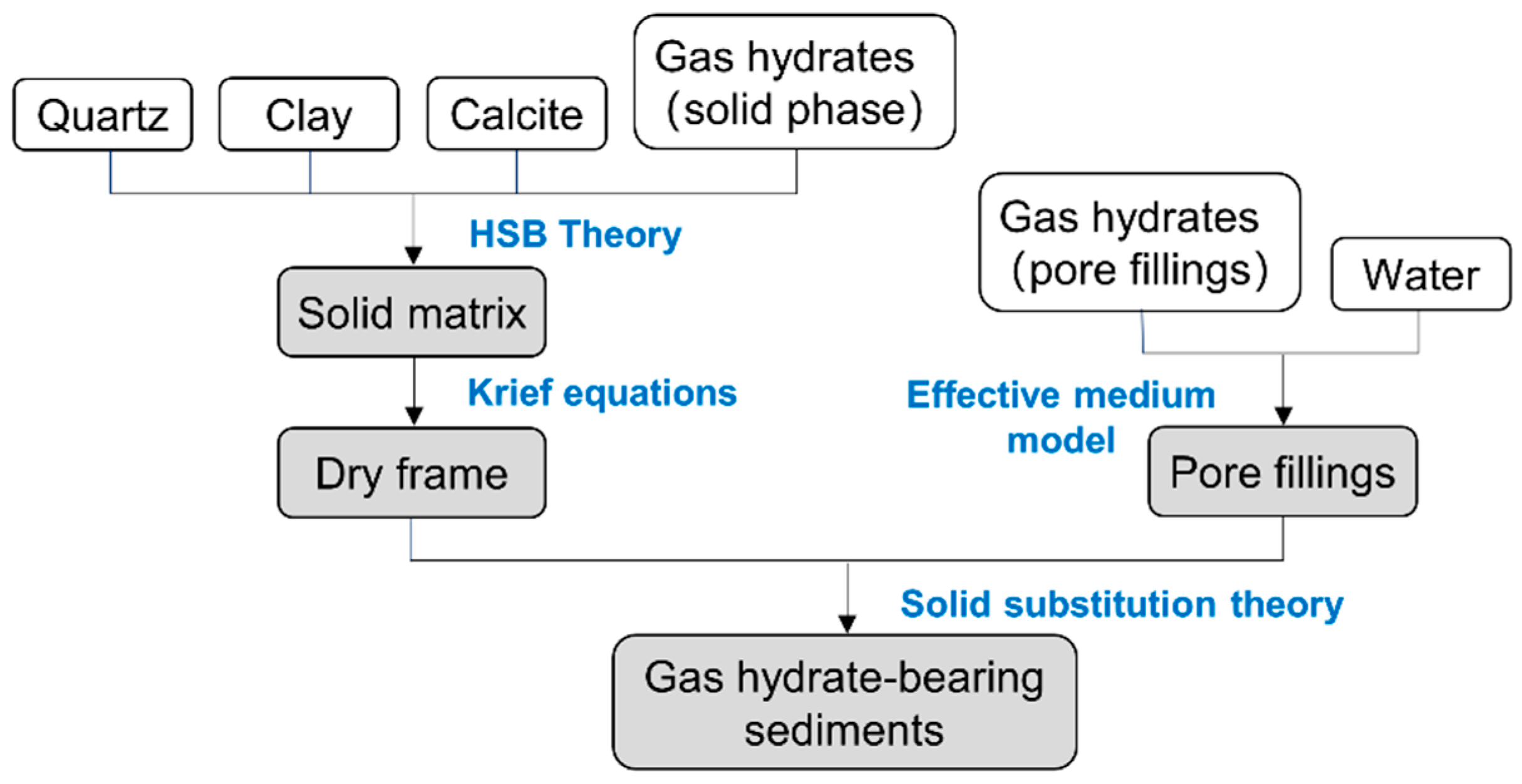
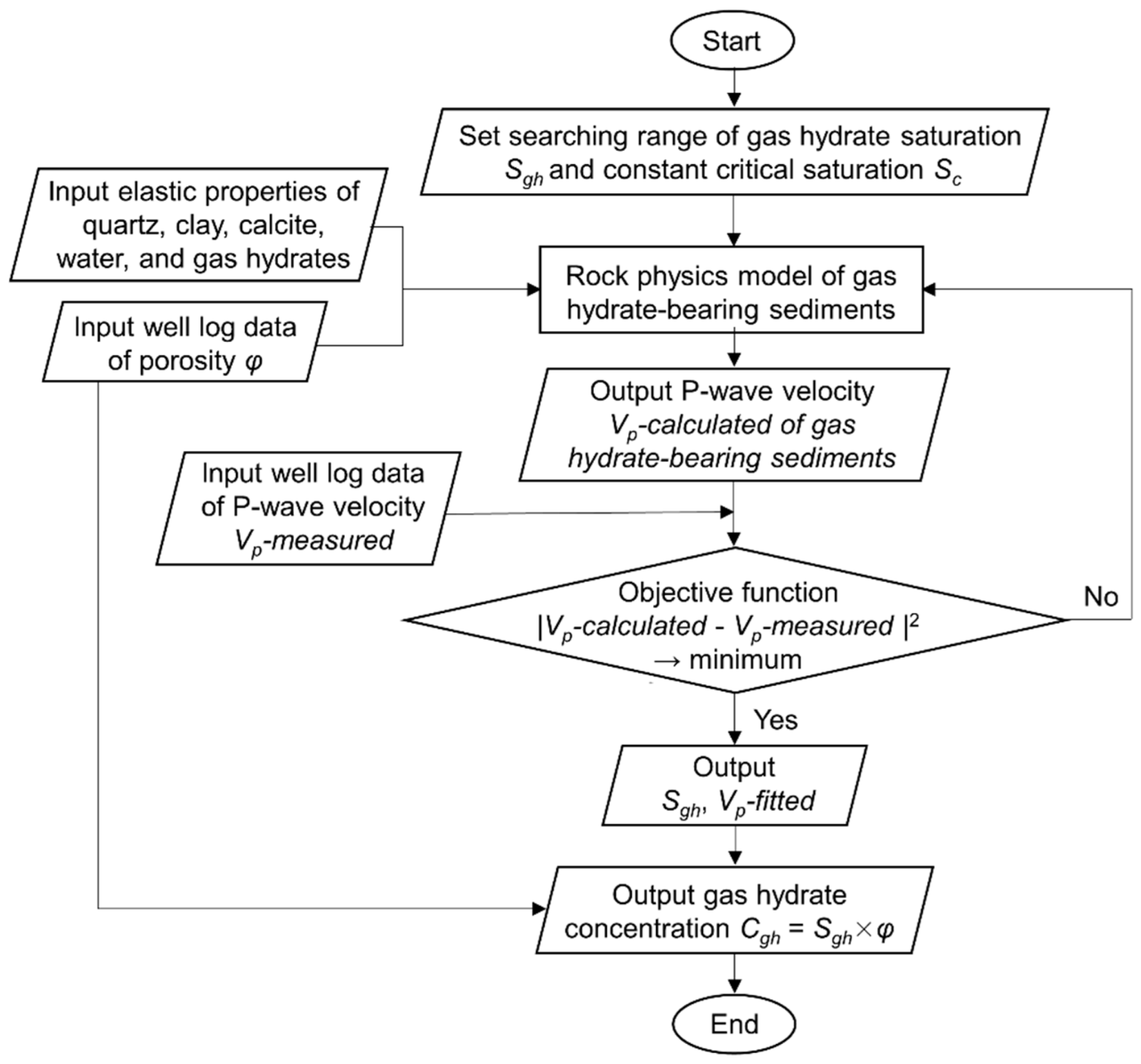
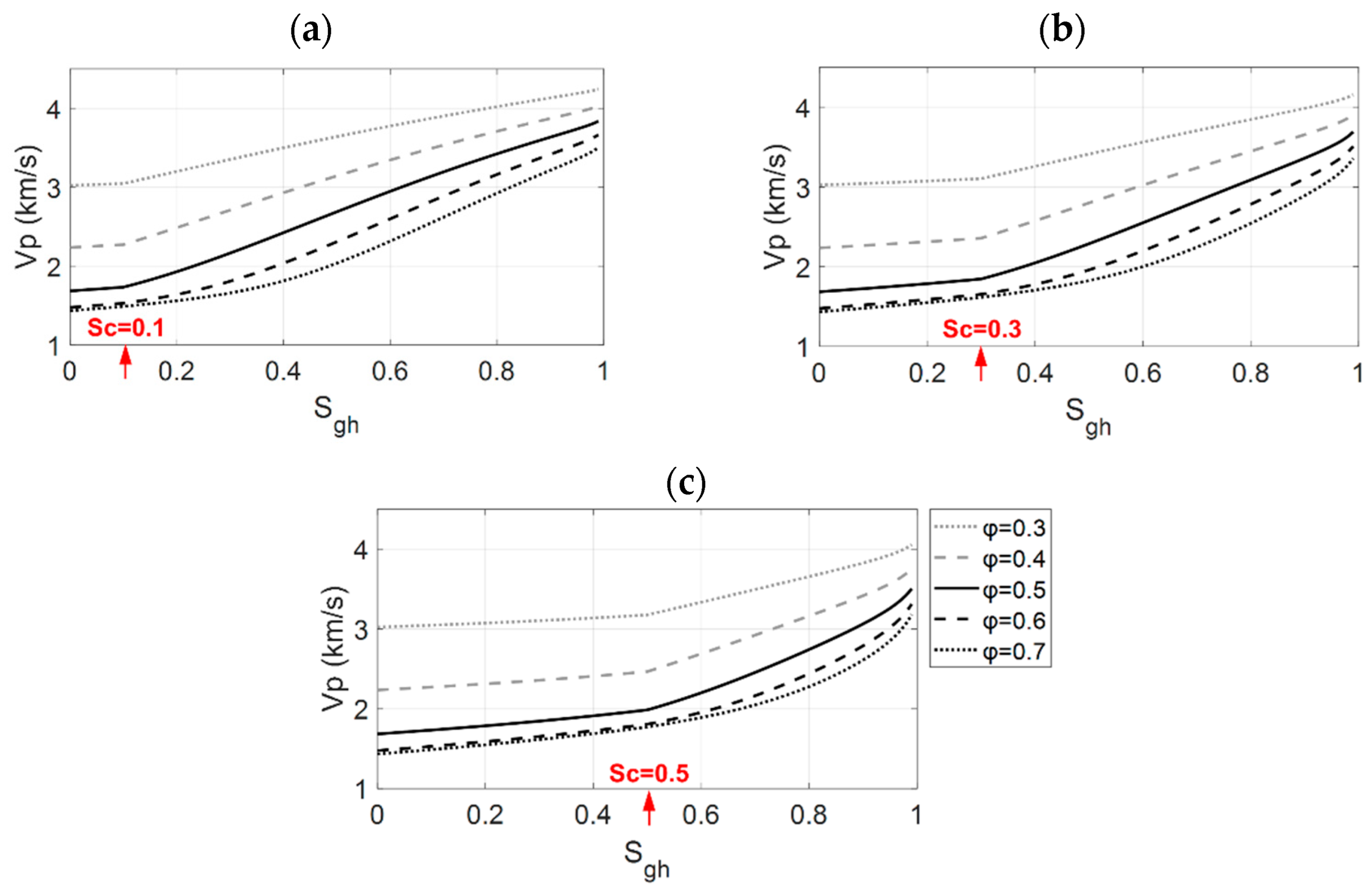
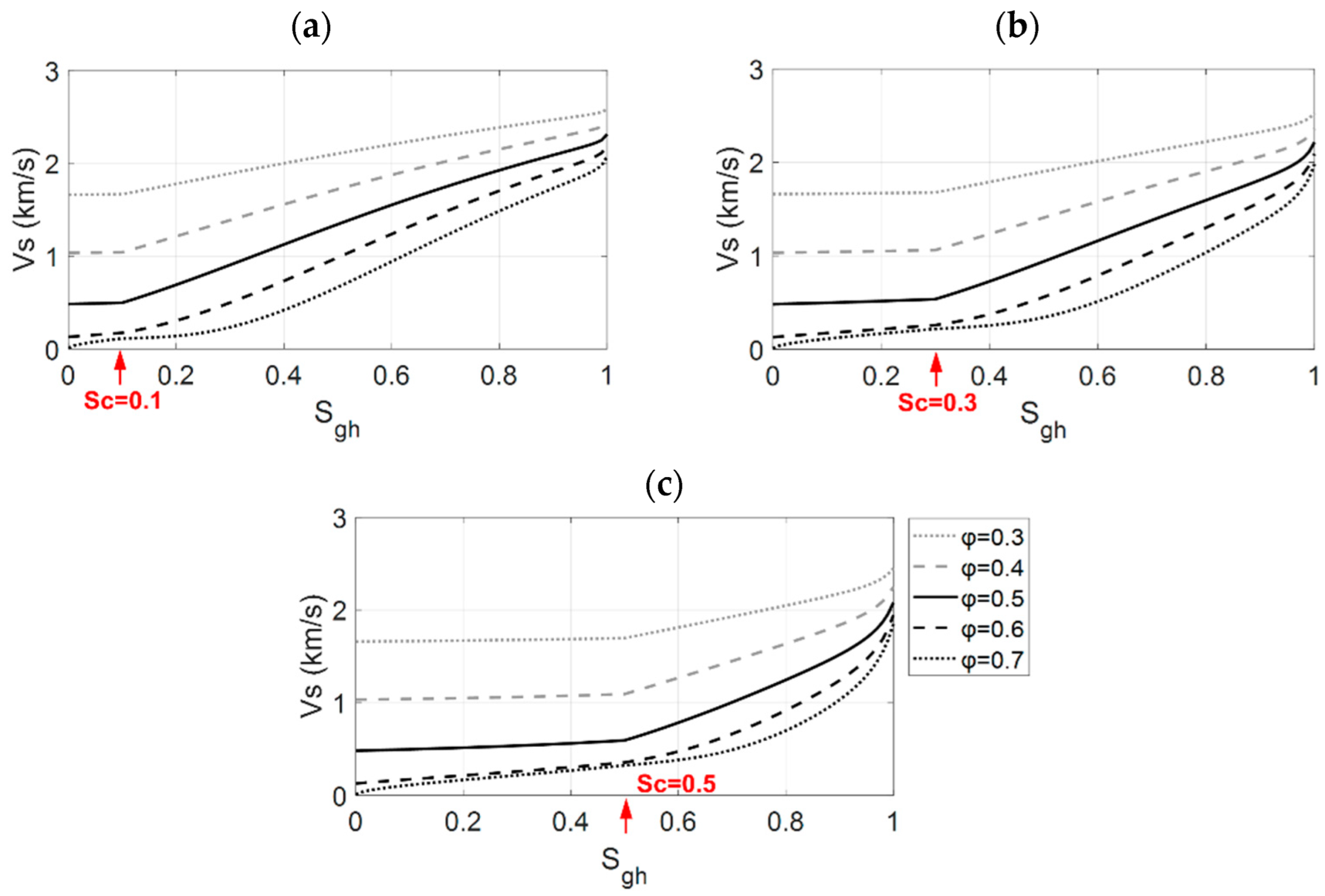
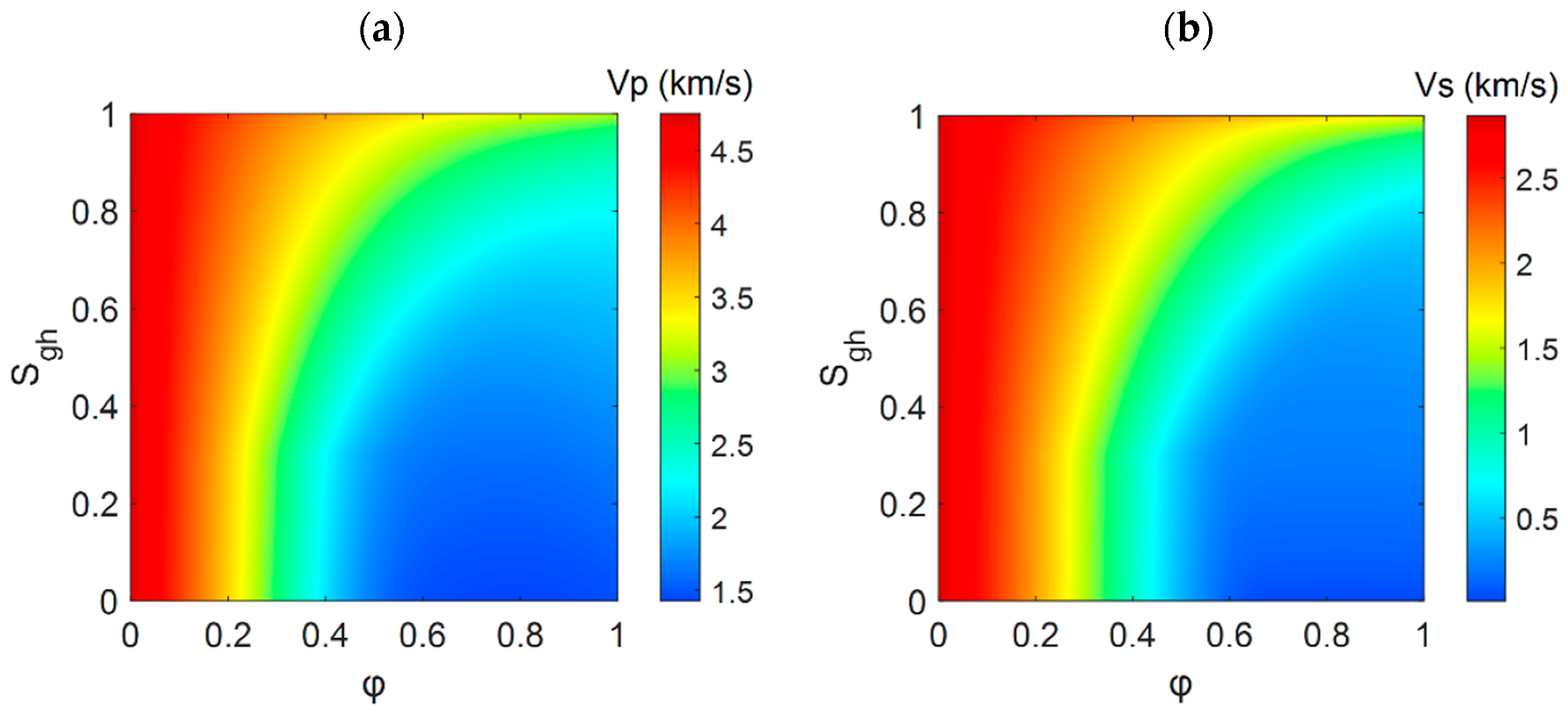

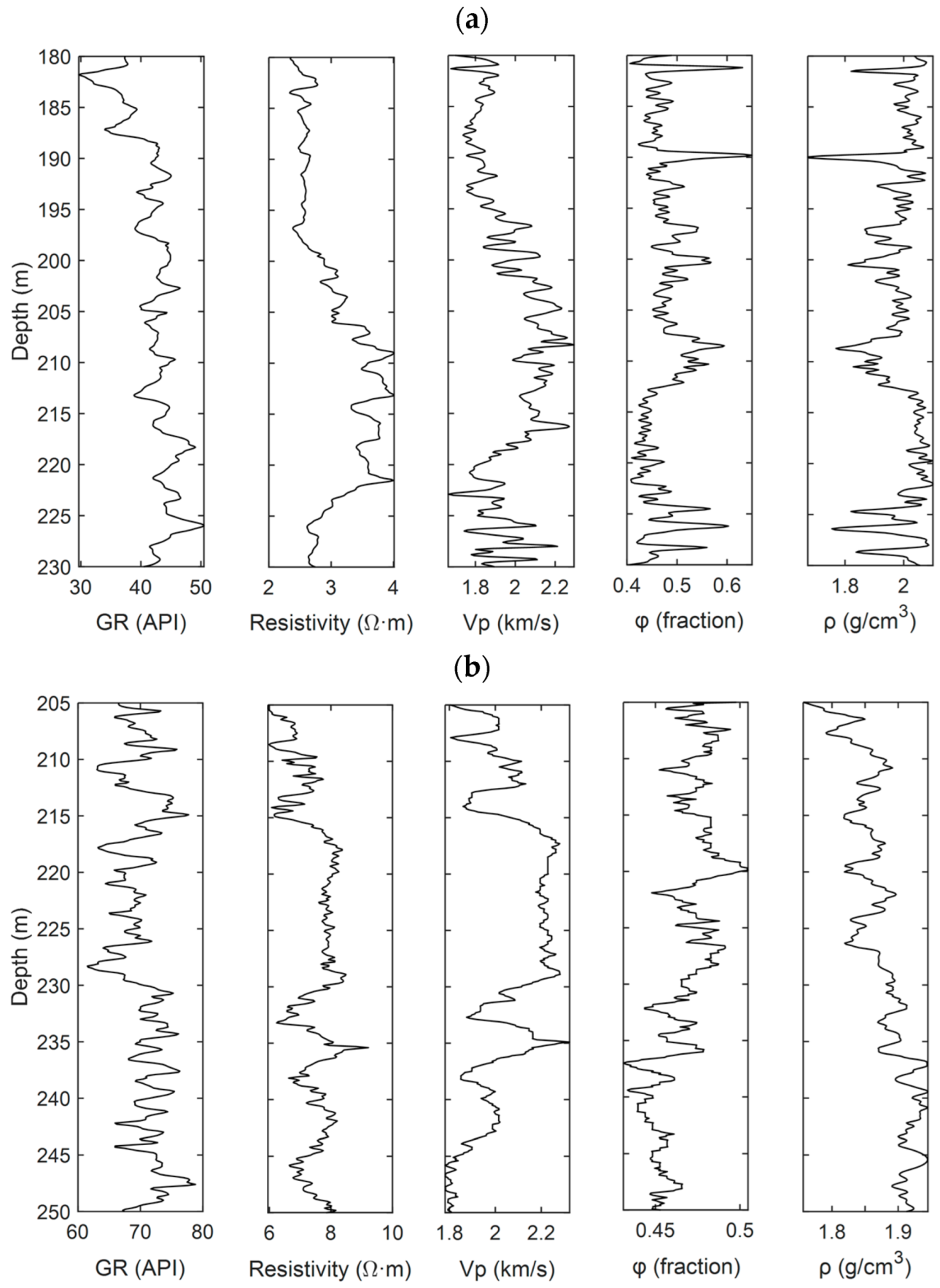
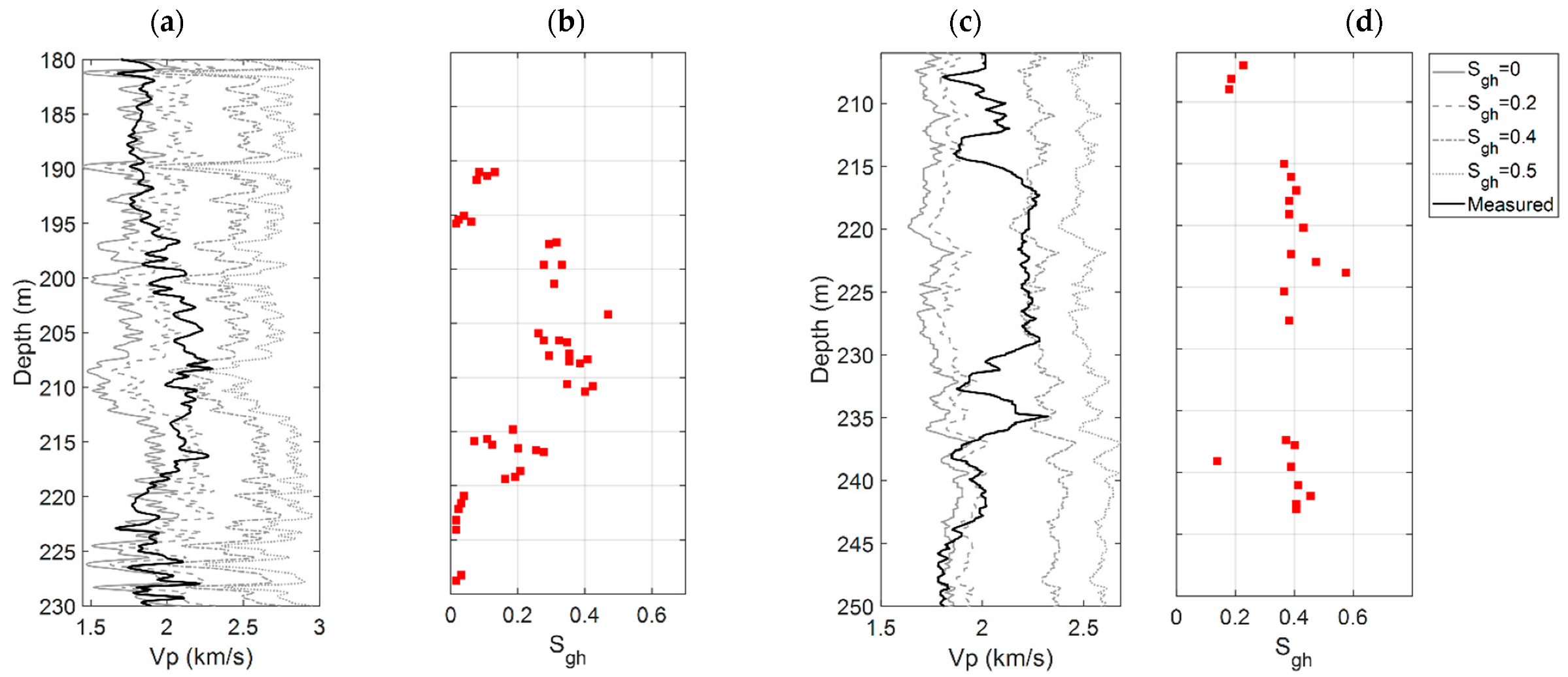

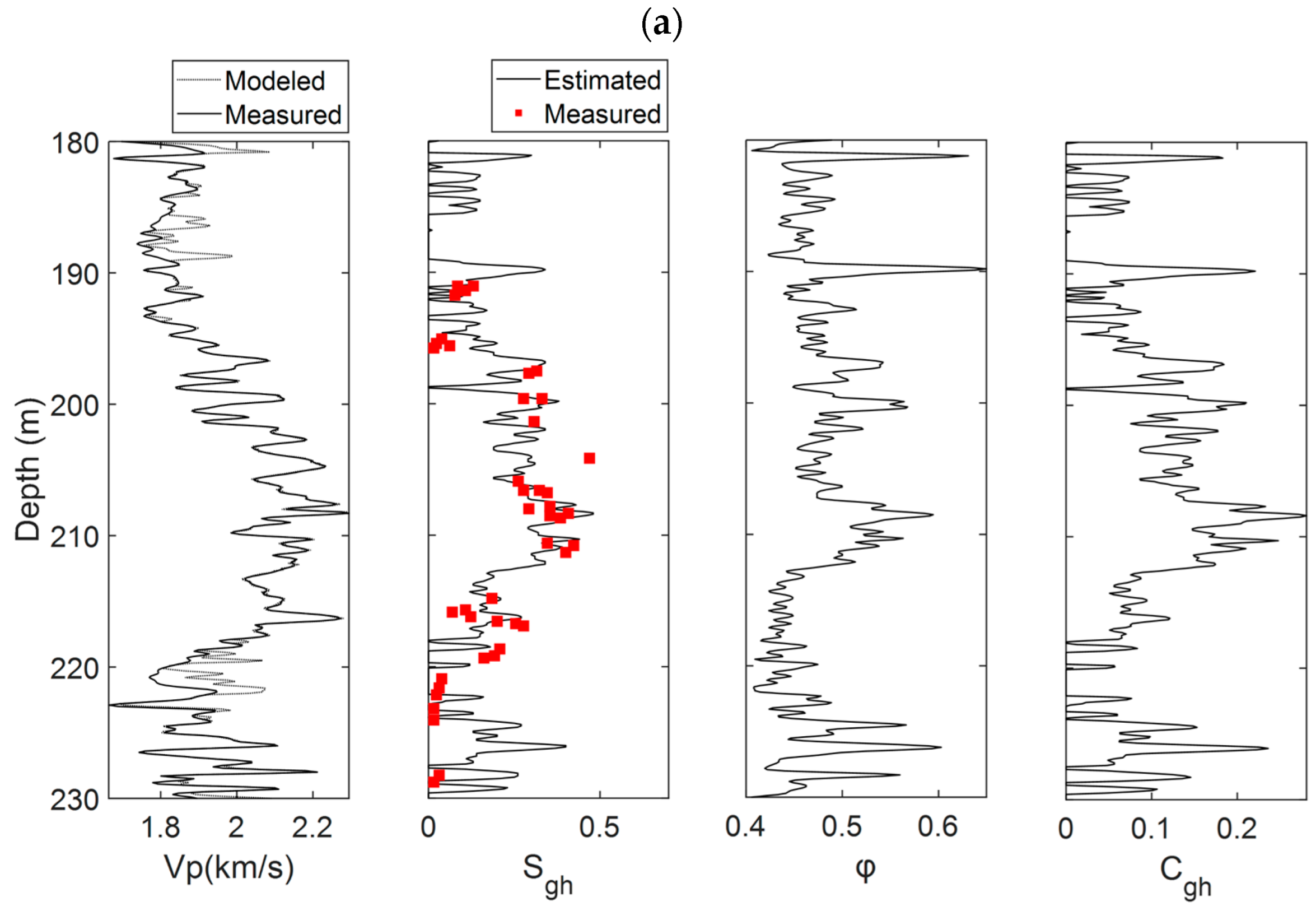
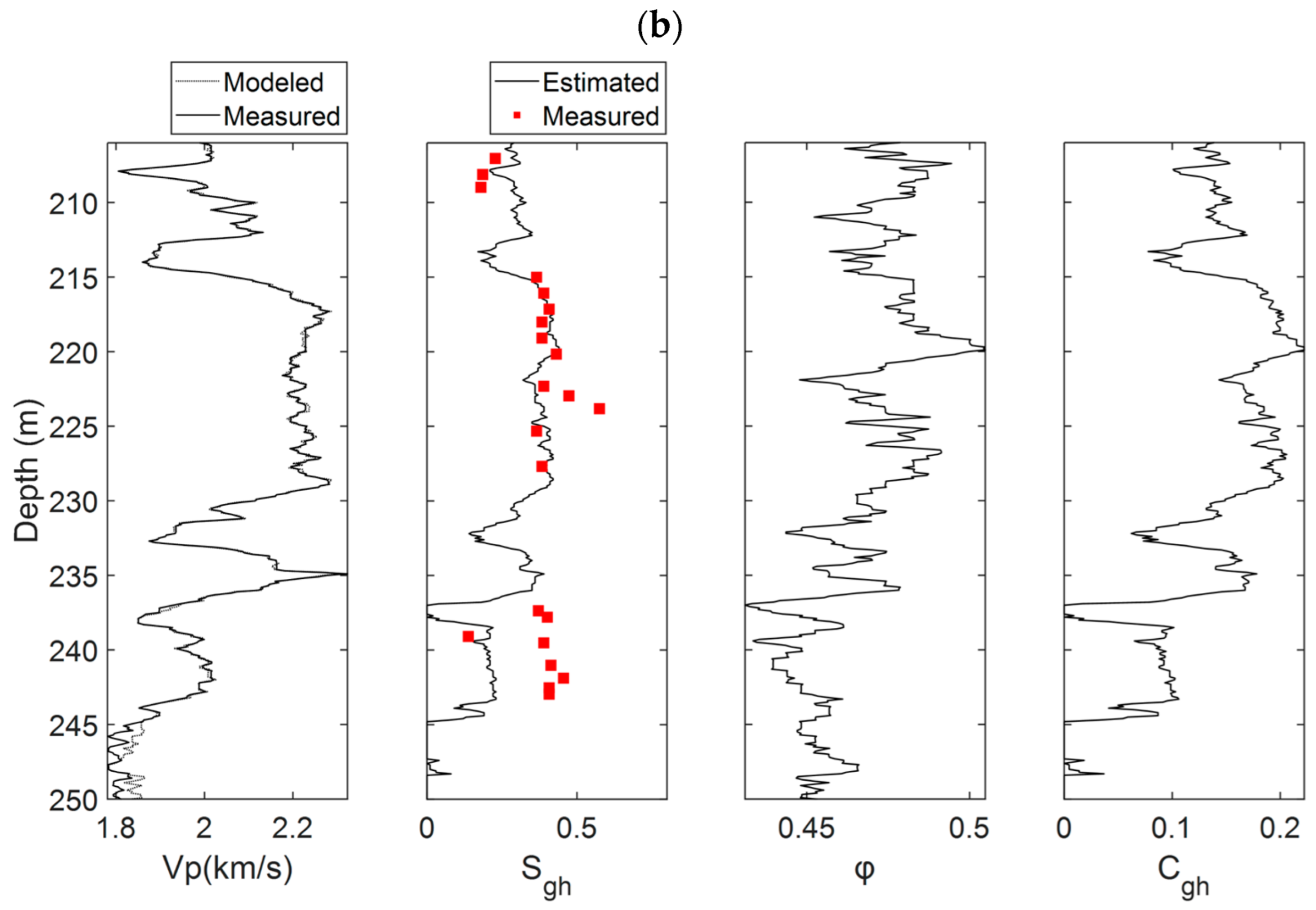
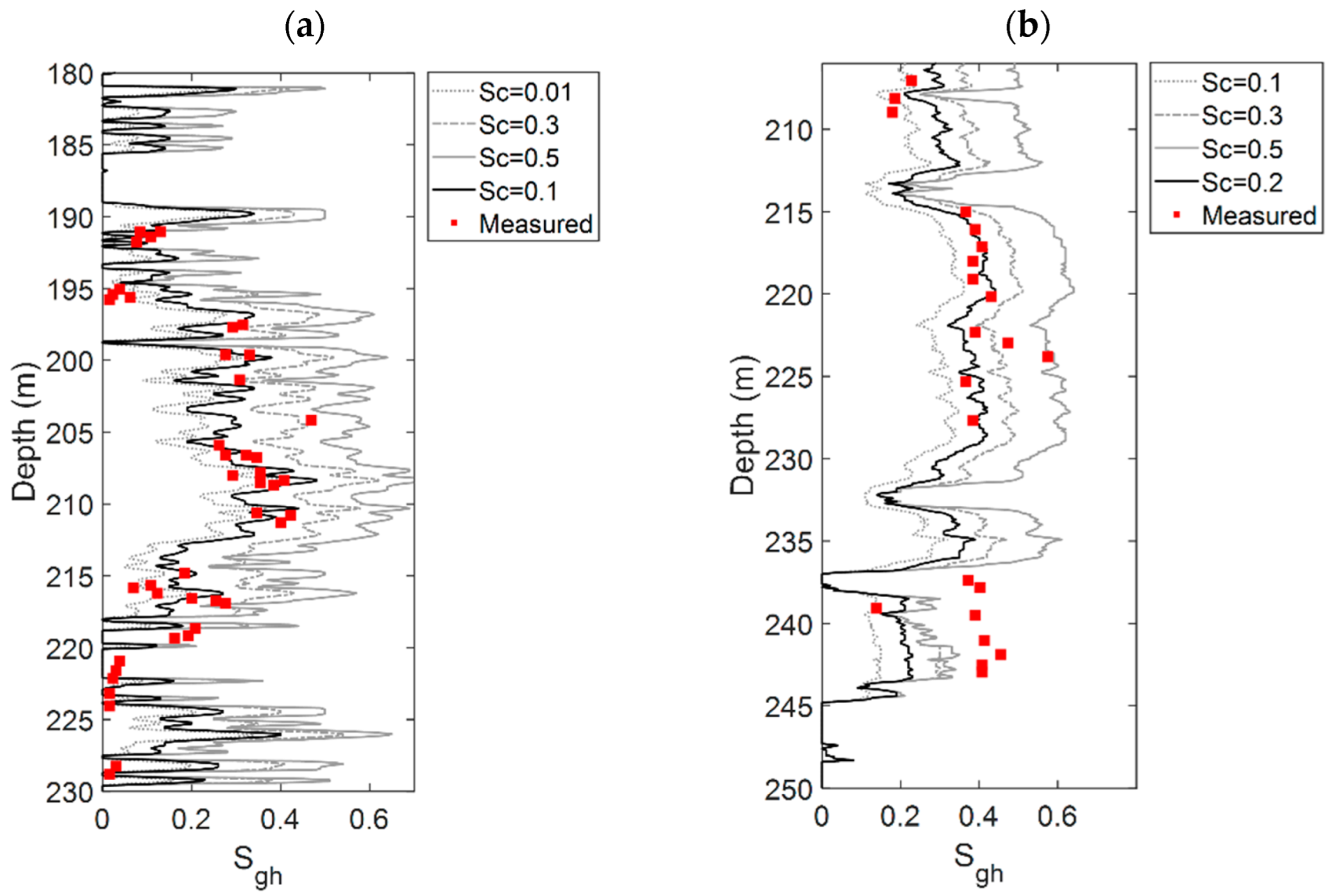

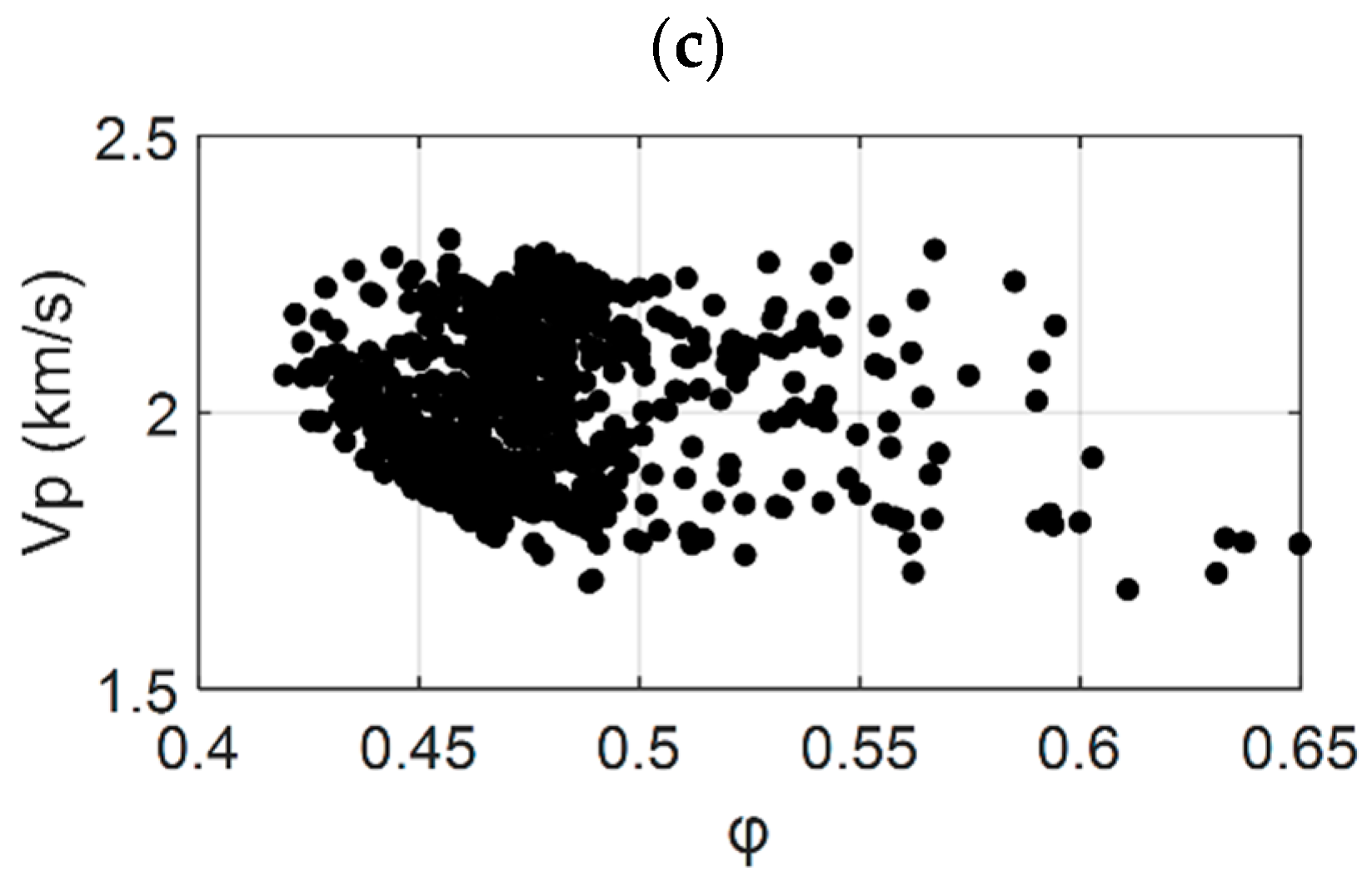
Publisher’s Note: MDPI stays neutral with regard to jurisdictional claims in published maps and institutional affiliations. |
© 2022 by the authors. Licensee MDPI, Basel, Switzerland. This article is an open access article distributed under the terms and conditions of the Creative Commons Attribution (CC BY) license (https://creativecommons.org/licenses/by/4.0/).
Share and Cite
Guo, Z.; Lv, X.; Liu, C.; Chen, H.; Cai, Z. Characterizing Gas Hydrate–Bearing Marine Sediments Using Elastic Properties—Part 1: Rock Physical Modeling and Inversion from Well Logs. J. Mar. Sci. Eng. 2022, 10, 1379. https://doi.org/10.3390/jmse10101379
Guo Z, Lv X, Liu C, Chen H, Cai Z. Characterizing Gas Hydrate–Bearing Marine Sediments Using Elastic Properties—Part 1: Rock Physical Modeling and Inversion from Well Logs. Journal of Marine Science and Engineering. 2022; 10(10):1379. https://doi.org/10.3390/jmse10101379
Chicago/Turabian StyleGuo, Zhiqi, Xiaoyu Lv, Cai Liu, Haifeng Chen, and Zhiguang Cai. 2022. "Characterizing Gas Hydrate–Bearing Marine Sediments Using Elastic Properties—Part 1: Rock Physical Modeling and Inversion from Well Logs" Journal of Marine Science and Engineering 10, no. 10: 1379. https://doi.org/10.3390/jmse10101379
APA StyleGuo, Z., Lv, X., Liu, C., Chen, H., & Cai, Z. (2022). Characterizing Gas Hydrate–Bearing Marine Sediments Using Elastic Properties—Part 1: Rock Physical Modeling and Inversion from Well Logs. Journal of Marine Science and Engineering, 10(10), 1379. https://doi.org/10.3390/jmse10101379







